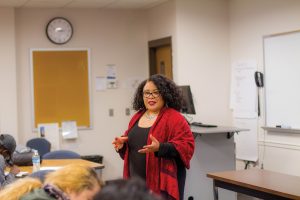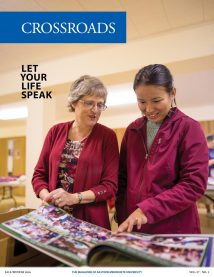
Sociology professor Melody M. Pannell ’97, a native of Harlem, New York, is a bridge-builder. “God desired to use my life as a vessel to transform the two societies that I represented,” she says. Melody returned to her alma mater to teach and to advocate for students of color and a more diverse faculty.
THE SEVEN-HOUR DRIVE from Harlem, New York City, to Harrisonburg, Virginia, was filled with excitement, anticipation and a sense of purpose. Somehow I knew that I would never be the same once I stepped into this “new land,” this unfamiliar place that I would soon call “home” for the next four years. Everything was different yet strangely comforting. I longed to feel a sense of belonging and acceptance.
My father, Richard W. Pannell, once told me he had visited Eastern Mennonite College as a teenager in the late 1950s. A group from Newlinville Mennonite Church in Coatesville, Pennsylvania, visited the college to hear the music of “The Holy City Oratorio.” He remembered a sense of peace and tranquility at the beautiful campus, feeling that this was the college that he wanted to attend. Although not raised in the Mennonite faith, he began attending the Mennonite Church as a teenager, drawn to the hospitality, care and loving spirit of Pastor Elmer D. Leaman and the congregation. Somehow they felt like “family.” He also was intrigued by the Anabaptist theology of peace, justice and service to the world. “Yes, this was the place for me,” he happily exclaimed to his mother upon his return home.
This was some lofty idea that my father had. Although EMC was the first predominately white college institution in the south to open its doors to African- Americans, very few African-American students found their “place” in this Mennonite academic society. Willis Johnson was the first African-American to enroll in 1948, although he did not graduate. Peggy Webb, another local student, was the first African-American graduate in 1954 – the same year as the landmark case, Brown v. Board of Education, and the beginning of the civil rights move-ment.
At the top of his class at Coatesville High School, my father’s capacity to achieve academically was not in ques- tion. Yet he was strongly encouraged to reconsider his plan to attend a predominately white college in rural Virginia. His mother worried if he would truly be welcomed in this close- knit community due to the history in the south of racial segregation. A member of the Baptist church, she was not as familiar with the Mennonites. However, she had experience with “white society” as an African-American woman growing up during the Jim Crow era. Consequently, my father never applied to EMC.
To my father, it was a dream dashed, a harsh reality of a dichotomy of community. He had embraced the Mennonite Church as a teenager, but Mennonite higher education was a different place. Little did he know that he would relive the dreams of his heart in 1993 when I began social work studies at Eastern Mennonite University.
I had worked with at-risk Black adolescent girls in Harlem and decided to study social work from a Christian perspective. I was raised at Seventh Avenue Mennonite Church on the corner of 146th Street and Adam Clayton Powell Jr. Blvd. in Harlem, where I learned about Anabaptist theology concerning peace and justice. I also knew of Black liberation theology and “existential preaching theology,” which supplied a divine Word that “answers a crisis or conflict at the heart of human existence,” and utilizes the model of ethical-political theology “where preachers proclaim God’s Word as an alternate vision to injustice, inequities of power, suffering, and oppression.”
With this in mind, I packed my belongings with enthusiasm, determination and hope. I was a Mennonite girl from Harlem who carried the hopes of her father as well as so many others in her African-American community – hopes that too often had been denied. I also represented the ideas of White Mennonite allies who believed in the value of racial diversity, advocated for social justice, and worked against systemic inequalities within the church community. One of these White Mennonites was my mother, Ethel M. Pannell, who had traveled from rural Lancaster County to New York City to serve as a missionary in Harlem during the height of the civil rights movement. There my parents met, married and raised three bi-racial children.

Professor Melody M. Pannell teaches a course on social work in November. (Photos by Jon Styer)
I am that Mennonite girl from Harlem who became part of the community of Eastern Mennonite University the moment that I stepped on campus. I felt “called” to this place, not only for my academic development, but also for my spiritual formation and personal transformation. I sensed that I had a purpose for being here. I was called to be a “bridge-builder.” I belonged, even if many people did not believe that I too was “Mennonite.” I was Mennonite through the ethnicity of my German-Swiss, Pennsylvania Dutch mother, and I was Mennonite by faith and the principles of Anabaptist theology through my African- American father who had served during my childhood as the first Black pastor of Seventh Avenue Mennonite Church.
I did not look like the majority of the students around me. I was also not from a rural or suburban area, nor was I from a higher socioeconomic status. I was from one of the most diverse and largest cities in the world. However, I represented a historically marginalized group of people who had experienced the trauma of prejudice, oppression and systemic discrimination. During the low points of my experience, I questioned whether or not I actually belonged at Eastern Mennonite University.
Yet I believed in the vision of EMU to be a “learning community marked by academic excellence, creative process, professional competence, and passionate Christian faith, offering healing and hope in our diverse world.” I believed it when EMU said that they commit themselves to “do justice, love mercy, and walk humbly with God.”
My fidelity to this place was strong. I was a loyal, supportive, dedicated and active member of the campus community. I remembered the voice of my mentor Marian Sauder Egli ’75, who had graduated from Eastern Mennonite Seminary when it was not “popular” for women to attend. “You need EMU, but EMU also needs you,” she exclaimed. I believed her. I became involved on campus as a ministry assistant, Celebration worship leader and Chapel Committee member, president of the Black Student Union, resident assistant, hall director and co-president of the Student Government Association.
I was able to make a few significant connections with peers, faculty members and the broader church community. This enabled me to move through the “transformation pyramid” of survival (physiological and safety), success (social belonging and esteem) and transformation (self-actualization). I began to share my ideas, utilize my creativity and open myself to be transformed through this cross-cultural experience. I also believed that God desired to use my life as a vessel to transform the two societies that I represented.
After graduating in 1997, I came “home” to my alma mater to become the director of multicultural services from 2003-08 and later in the fall of 2015, I returned once again to my fidelity of place to become a professor of social work. It was a dream fulfilled to be a part of increasing the diversity of faculty members at EMU.
My story however is unfortunately an exception and not the normal experience of students of color who attended EMU. This leads me to the question: How can Mennonite institutions go beyond the practice of hospitality to create and utilize a framework of particular education theories, philosophies and perspectives that enhance our efforts to empower our multicultural students to overcome cultural barriers that separate them from becoming engaged in the community of learners, contributing their unique gifts and thriving in the place we ask them to call home?
During my studies in Christian education, a few of my favorite authors shed some light on the empowerment, liberation and transformation of educational communities.
Ira Shor in Empowering Education: Critical Teaching for Social Change, suggests that curriculum should “empower students … be transformative in nature” and help to make students “social critics.”
Brazilian educator Paulo Freire taught in Pedagogy of the Oppressed that “Education either conditions the younger generation into acceptance of society’s status quo or becomes ‘the practice of freedom’ through which people deal critically and creatively with reality and discover how to transform their worlds.” Freire revolutionized educational thinking by proposing that liberation and education were equivalent and mutual processes. In other words, “education is necessary for the liberation of communities of oppressed people, and education and liberation are partnerships that must work together for the good of all communities.”
Quaker educator Parker Palmer says in To Know As We Are Known: Education as a Spiritual Journey, that this “transformation” should be the goal and objective of our educational efforts and that the spirituality of our students plays a significant role in the successful development and formation of their educational journey. “Such spirituality encourages us to welcome diversity and conflict, to tolerate ambiguity, and to embrace paradox.”
I believe that it is a beautiful and worthwhile journey of learning that we can take as a community. However, we must tap into a new way of relating to and educating our multicultural students. It is not just about what our Mennonite institutions can teach those that represent different cultures. It is about what embracing diversity can teach us. Together we can engage, empower and transform our Mennonite communities and create an inclusive fidelity of place that will be sustained, transform our society and flourish into the future.
